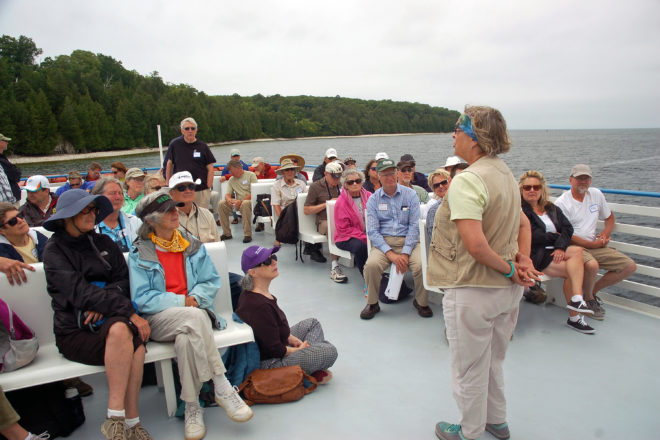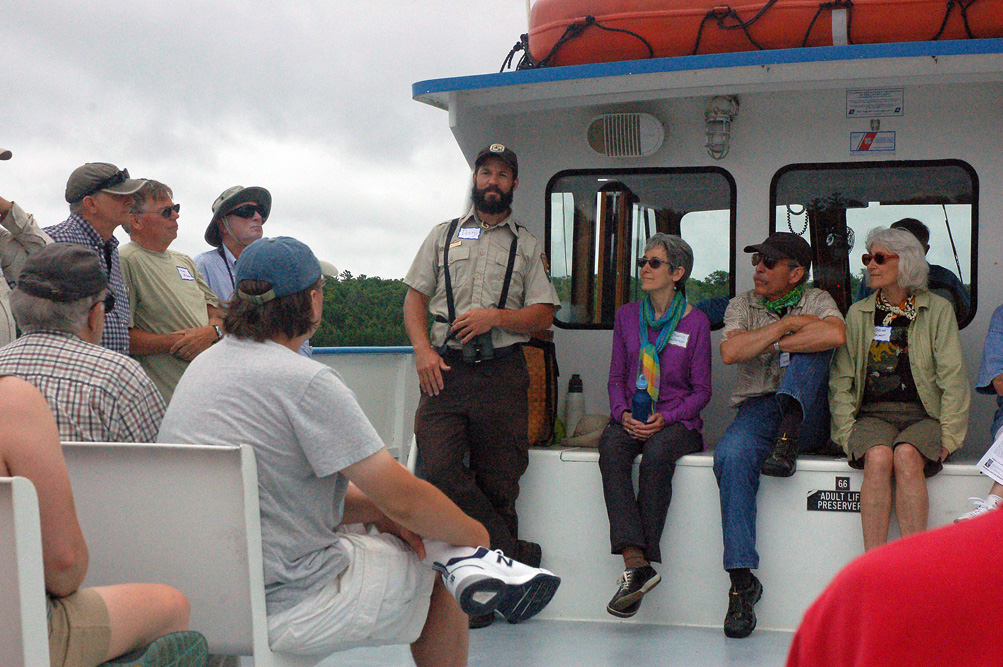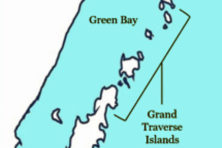The Great Arc Corridor: National Geographic Interested in Geotourism Collaboration
- Share
- Tweet
- Pin
- Share

A convergence of likeminded geotourism advocates could help put the Niagara Escarpment on the map – literally.
Last week and early this week, Jim Dion, sustainable tourism program manager with the National Geographic Society’s maps division, spent time in Dodge, Calumet and Door counties to discuss with various stakeholders the idea of creating a regional tourism collaboration for the entire Niagara escarpment region called The Great Arc Corridor.

The Island Clipper from Gills Rock paid a visit to St. Martin Island as part of a Grand Traverse Islands tour.
“The project is not a project yet,” Dion said. “What we’re doing, we’re looking to engage local stakeholders and people in the region about the possibility of doing a project in the region. It’s important that these programs are done in cooperation with local people and stakeholders. We’re trying to help create opportunities for people involved in conserving and preserving their sense of place.”
“Music to my ears!” said Nancy Goss, a Liberty Grove supervisor and member of the Greater Escarpment Organization of Door County (GEO-DC), which was been meeting since 2012 to make the escarpment a greater attraction.
“Everything he talked about is consistent with the GEO-DC vision,” Goss said. “Many of the same concepts – sense of place, geotourism, ecotourism.”
Dion has worked with other regions around the country to create geotourism collaborations.
“I call it sometimes the anti-National Geographic project,” he said. “Instead of parachuting in writers and photographers, we engage local people to tell us the story of their place, a coalition of the willing to work with us to be able to tell the story of their place through their eyes, their words and their vision. That’s what sets these projects apart.”
Mary Somnis, director of the Economic Development Authority of Cook County/Grand Marais, Minn., went through the process of creating a geotourism identity with Dion and many other stakeholders in a project to highlight the public lands of northeastern Minnesota and southern Ontario. They called it the Heart of the Continent Geotourism Program (traveltheheart.org).
“If you look at the map of North America, we are the heart of the continent,” Somnis said.
Somnis said the idea of a regional tourism partnership in that part of the country had been around for a while. In 2011 an international gathering was held for stakeholders, with four days of workshops and presentations.
“The idea was for teams of people within communities to come up with ideas – sustainable tourism or any other kinds of initiatives such as local foods or renewable energy. It ran the gamut of ideas,” she said.
One of the presenters was Jim Dion.
“After being here and seeing our region, he asked us if we would like to consider being a National Geographic tourism region. Our response was overwhelmingly positive,” Somnis said. “One of our goals was to create a regional identity, so that really enabled us to go forward toward achieving that goal.”
“They’ve been in existence for years but they never did anything with tourism,” Dion said of the Heart of the Continent region. He also mentions recently finishing a similar project with the Delaware River National Recreation Area, which encompasses three states that were not collaborating in promotion of the region.
“The idea was to create a stakeholder organization among the people in these states that didn’t exist,” he said.
“The idea is to create a long-term relationship with National Geographic through what we call a geotourism stewardship council, basically a destination management organization, that will own and maintain whatever results from the program.”
The first step is identifying the objectives of the program.
“What are the key messages and long-term strategy to be able to inspire people to come and visit your place in a way that benefit local communities?” Dion said. “We will be introducing those concepts and how we have done this methodology in other places, and how it might be customizable and adoptable in this situation.”
While here, Dion gave presentations to various groups, including close to 150 people who signed up for a tour of the Grand Traverse Islands aboard the Island Clipper sailing out of Gills Rock on July 24. Along with presenting the National Geographic geotour idea, the captive audience aboard the Island Clipper also heard from a variety of local experts on everything from the geology of the escarpment to shipwreck history of the lake, all of which are components of the geo-tourism idea.

Dusty Hoffman talks about being the first U.S. Fish and Wildlife team member assigned to the Green Bay Natural Wildlife Refuge.
Creating these collaborations with local stakeholders to draw more visitors to the region is good for everyone in that region, Dion said.
“If you look at small stakeholders, they are part of tourism,” he said. “It can be the local souvenir shop that benefits, or it can be the local grocery store or the local auto mechanic that benefits from it. Sometimes an interjection of a few hundred more visitors is what keeps the local restaurant open.”
Dion also noted that this was his first trip to the area.
“You have a pretty special place in Door County,” he said. “It’s such a strong destination awareness identity. I can see this very fast-tracked.”
So, stay tuned for further developments.


